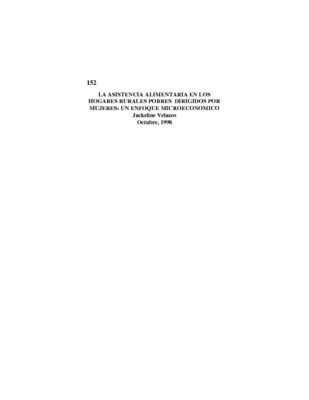| dc.contributor.author | Velazco Portocarrero, Jackeline | |
| dc.date.accessioned | 2015-03-17T16:11:17Z | |
| dc.date.available | 2015-03-17T16:11:17Z | |
| dc.date.issued | 1998 | |
| dc.identifier.uri | http://repositorio.pucp.edu.pe/index/handle/123456789/46792 | |
| dc.description.abstract | El objetivo del documento es discutirr a partir de un modelo de microeconomico, los efectos de la asistencia alimentaria en los hogares rurales pobres dirigidos por mujeres. De acuerdo con los resultados del Censo Agropecuario de 1994, este tipo de hogares alcanza al 20% del total y constituye uno de los sectores más pobres del país. Esta situacion los convierte en uno de los “Grupos objetivos” de los programas de asistencia social realizados por las instituciones del gobierno. El modelo desarrollado considera la asignacion del tiempo de la mujer en tres actividades: El trabajo en la chacra, las tareas domésticas y el descanso. Se asume un nivel mínimo de alimentos que deben ser producidos en la finca familiar. Además, las horas dedicadas a las actividades domésticas están dadas. En ese contexto se discute cuál es la intervención más adecuada para mejorar los ingresos y el nivel de bienestar de la mujer rural jefa de hogar (aumento de las horas de descanso), a partir de la evaluación de las políticas de asistencia alimentaria y de los programas productivos (como asistencia técnica, crédito, entre otros). El análisis teórico realizado muestra las limitaciones de los programas de asistencia alimentaria y sugiere que sean complementados con los programas productivos. | es_ES |
| dc.description.abstract | The aim of this document is to discuss, on a microeconomic basis, the effect of food assistance in poor rural female headed households. According to the results of the 1994 Farming Census these homes are the twenty percent of the total. Since they are considered to be one the poorest sectors of the country, they have become the target groups of social support programs carried out by government institutions. The model developed considers the distribution of the time of the woman in three activities: working on the land, the domestic chores and the time to rest. A minimum level of food, which should be produced in the family farm, is assumed. Besides, the hours dedicated to the domestic chores are given. In this context, the most adequate intervention to improve the income and the welfare (an increase on the time to rest) of the rural woman -who is the head of the house-, based on the evaluation of the food assistance policies and the productive programs (technical assistance and credit for instance), are discussed. The theoretical analysis carried out shows the limitations of food assistance programs and suggests that they should be complemented with the productive programs. | en_US |
| dc.language.iso | spa | es_ES |
| dc.publisher | Pontificia Universidad Católica del Perú. Departamento de Economía | es_ES |
| dc.relation.ispartofseries | Documento de Trabajo;152 | es_ES |
| dc.rights | info:eu-repo/semantics/openAccess | es_ES |
| dc.rights.uri | http://creativecommons.org/licenses/by-nc-nd/2.5/pe/ | * |
| dc.subject | Alimentos--Abastecimiento--Perú--Zona Rural | es_ES |
| dc.subject | Mujeres y pobreza--Perú--Zona rural | es_ES |
| dc.title | La asistencia alimentaria en los hogares rurales pobres dirigidos por mujeres : un enfoque microeconómico | es_ES |
| dc.title.alternative | Food assistance for poor, women-headed rural households: A microeconomic approach. | en_US |
| dc.type | info:eu-repo/semantics/workingPaper | |
| dc.type.other | Documento de trabajo | |
| dc.subject.ocde | http://purl.org/pe-repo/ocde/ford#5.02.00 | |
| dc.publisher.country | PE | |
| renati.advisor.orcid | https://orcid.org/0000-0001-5554-2198 | |


